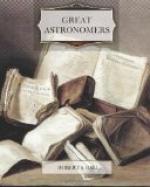But quite independently of astrology there seem to have been many other delusions current among the philosophers of Kepler’s time. It is now almost incomprehensible how the ablest men of a few centuries ago should have entertained such preposterous notions, as they did, with respect to the system of the universe. As an instance of what is here referred to, we may cite the extraordinary notion which, under the designation of a discovery, first brought Kepler into fame. Geometers had long known that there were five, but no more than five, regular solid figures. There is, for instance, the cube with six sides, which is, of course, the most familiar of these solids. Besides the cube there are other figures of four, eight, twelve, and twenty sides respectively. It also happened that there were five planets, but no more than five, known to the ancients, namely, Mercury, Venus, Mars, Jupiter, and Saturn. To Kepler’s lively imaginations this coincidence suggested the idea that the five regular solids corresponded to the five planets, and a number of fancied numerical relations were adduced on the subject. The absurdity of this doctrine is obvious enough, especially when we observe that, as is now well known, there are two large planets, and a host of small planets, over and above the magical number of the regular solids. In Kepler’s time, however, this doctrine was so far from being regarded as absurd, that its announcement was hailed as a great intellectual triumph. Kepler was at once regarded with favour. It seems, indeed, to have been the circumstance which brought him into correspondence with Tycho Brahe. By its means also he became known to Galileo.
The career of a scientific professor in those early days appears generally to have been marked by rather more striking vicissitudes than usually befall a professor in a modern university. Kepler was a Protestant, and as such he had been appointed to his professorship at Gratz. A change, however, having taken place in the religious belief entertained by the ruling powers of the University, the Protestant professors were expelled. It seems that special influence having been exerted in Kepler’s case on account of his exceptional eminence, he was recalled to Gratz and reinstated in the tenure of his chair. But his pupils had vanished, so that the great astronomer was glad to accept a post offered him by Tycho Brahe in the observatory which the latter had recently established near Prague.
On Tycho’s death, which occurred soon after, an opening presented itself which gave Kepler the opportunity his genius demanded. He was appointed to succeed Tycho in the position of imperial mathematician. But a far more important point, both for Kepler and for science, was that to him was confided the use of Tycho’s observations. It was, indeed, by the discussion of Tycho’s results that Kepler was enabled to make the discoveries which form such an important part of astronomical history.




